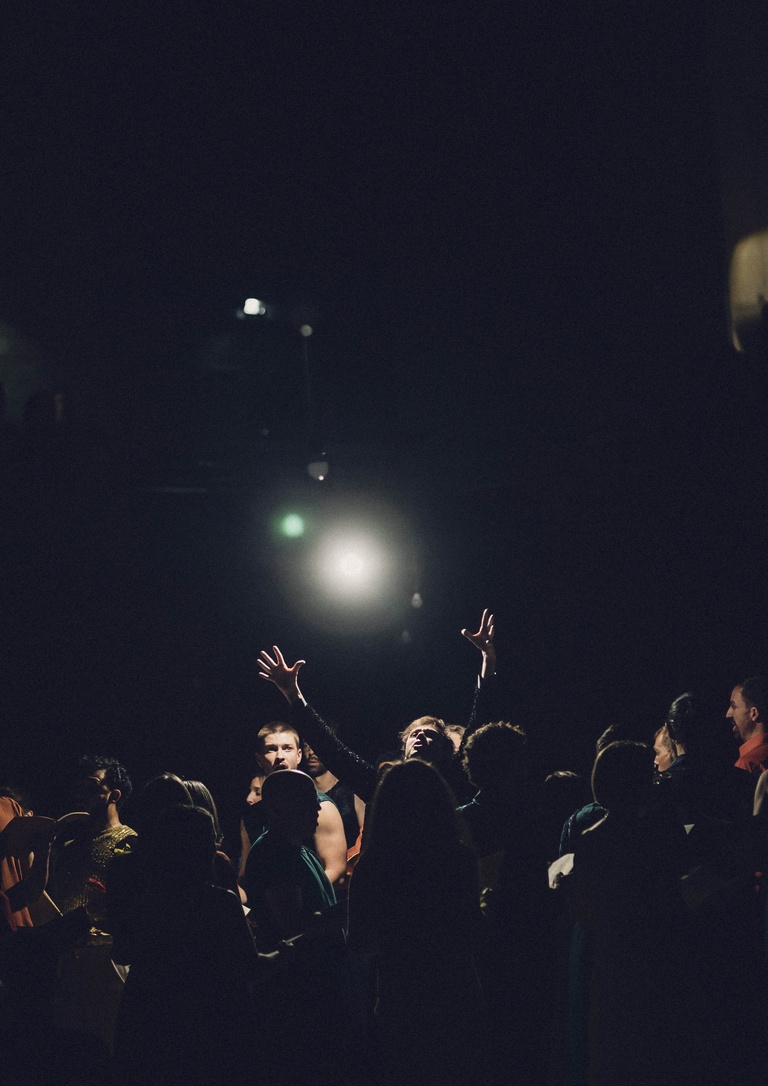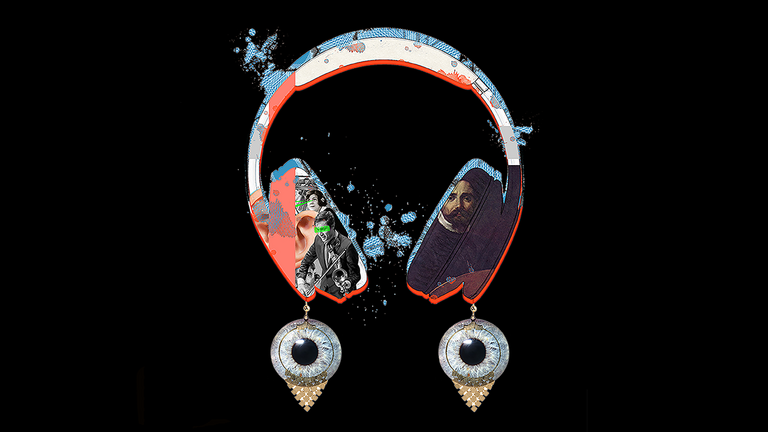
Sonntag aus Licht, the movie
Karlheinz Stockhausen
Sonntag aus Licht
Musical direction Maxime Pascal
Stage direction Ted Huffmann
A film by David Daurier
The day of the mystical union of Michael and Eve, Sonntag bewitches the senses and brings the opera LICHT to a close.
Discover now on Philharmonie Live the complete recording of the 2023 performances, directed by David Daurier.
Watch the film on Philharmonie Live
Scene 1 : Lichter-Wasser | Light-Waters
The earth and the life it shelters are born from the union of light and water. Lichter-Wasser, which is also Monday's greeting, opens with a synthesizer duet between Eve and Michael, soprano and tenor, who then accompany the entrance of the orchestra's musicians. They take their places among the audience, arranged in triangles oriented towards the center, turning the hall into a star. Each musician has a light, blue for the seventeen instruments in the high registers, corresponding to Michael's formula, and green for the twelve instruments in the low registers, corresponding to Eve's formula. Each instrument plays only one note or a brief fragment of one of these formulas. The resulting circulation of timbres swirls through space, in two simultaneous layers and twelve successive waves, like the planets and moons of the solar system, whose names, characteristics and symbology permeate the libretto. The process is interrupted by six bridges, which merge the two formulas, and by three announcements, a kind of recitative. At the end, the musicians drink water and retire, soprano and tenor singing a duet, while the lights continue to shine.
Scène 2 : Engel-Prozessionen | Angel Processions
Seven groups of angels move around the audience, extolling the love of God, “Holy Spirit of the Cosmos”, and celebrating the mystical union of Michael and Eve. Six of these groups, the Angels of Water (Monday Angels, light green), the Angels of Earth (Tuesday Angels, light red), the Angels of Life (Wednesday Angels, light yellow), the Angels of Music (Thursday Angels, light blue), the Angels of Light (Friday Angels, orange) and the Angels of Paradise (Saturday Angels, dark blue), sing in six voices, in Hindi, Chinese, Spanish, English, Arabic
and Swahili respectively. The seventh group, the Angels of Joy (Sunday Angels, gold), featuring four soloists, including the soprano and tenor in the first scene, sings in German. These groups each produce a two-voice polyphony, with the upper voice derived from Eve's formula, and the lower voice from Michael's. A choral tutti, of up to twenty-four voices, surrounds the audience, giving the first syllables of the days of the week and gently retaining sounds from Sunday, but also from Tuesday and Wednesday, in the superformula at the origin of the Licht cycle.
Symbolizing mystical union, the polyphonies gradually coalesce, to the point where the singers converge, musically and scenically, towards a homophony in the middle of the hall, with irises and lilies. The scene comprises seven phases of seven waves. Through 49 sections, not exempt from tiling, text, gestures and formulaic elements are perpetually reorganized. All in all, a vast procession from duality to unity.
Scène 3 : Licht-Bilder | Light-Paintings
Originally entitled “Veneration of Eva-Maria”, Licht-Bilder brings together 2 x 2 musicians, doubling a duo: Ève (flute and basset-horn) and Michaël (tenor and trumpet), a quartet reflected by the four screens and their “images of light”. It is a song of prayer, praise and thanksgiving, like a Gloria in which the elements, from the infinitesimal to the universe and beyond, from the stone to the stars and God, are associated with the days of the week, which follow one another in the course of the scene. Stockhausen has divided 2 x 2 types of formula into 53 fragments (corresponding to the addition of the first seven numbers of a Fibonacci sequence: 1 + 2 + 3 + 5 + 8 + 13 + 21), reordered them in retrograde form (from 53 to 1), and associated them with horizontal, vertical, diagonal and circular gestures. The union of Michael and Eve is symbolized by the interweaving of these fragments and gestures. The basset-horn and tenor parts shift and transpose the flute and trumpet, themselves altered by ring modulation - distensions and contractions in time and space, from nearer to farther and back again, creating ample breaths. The structure is nevertheless broken by several interludes, in duo, trio or quartet.
Scène 4 : Düfte-Zeichen | Scents-Signs
While the seven Licht emblems are explained in turn by six vocal soloists, seven fragrances evoke geographical areas: "Cúchulainn, a perfume of Celtic origin, for Monday; kyphi, a sacred fragrance whose formulation was found on the walls of a temple in the Nile Valley, for Tuesday; mastic, of Greek origin, for Wednesday; the Italian perfume rosa mystica, for Thursday; tate yunanaka, an aromatic composition used in the Andes, for Friday; and for Saturday, ud, agarwood, a balm that belongs to the ancestral tradition of India. Sunday is reserved for a more well-known fragrance, used in Christian rites: incense. On seven podiums, the soloists, with their codified gestures and colors, perform three solos, three duets and a trio on the themes of the days of the week, interspersed with more freely paced ensemble sequences; they also burn the perfumes one by one, celebrating their origins and benefits. An alto voice sounds from outside the hall, introducing herself as Eve-Marie. The six soloists run, shout and sing in agitation, before returning in procession with the viola for a harmonic chant (Oberton-Gesang). Ève calls Michaël, in the guise of a young boy, and sings a mystical duet with him on the central podium, before they enter another world behind it.
Scenes 5 and 6 : Hoch-Zeiten | High-Times
A celebration of love, marriage, angels and nature, in five languages (Hindi, Chinese, Arabic, English and Swahili), borrowing from Kâlidâsa's L'Exposition des saisons, or Sheikh Nefzaoui's erotic manual The Perfumed Meadow, Hoch-Zeiten is performed simultaneously in two separate rooms, by five choral sextets or octets in one, and five instrumental sextets facing each other in the other. On seven occasions, the music from one of the rooms is retransmitted to the other.
In a second performance, the audience is invited to change venues. The layout of the orchestral version, with its complex superimpositions, is identical to that of the choral version, but includes five duets and two trios, which are reminiscent of key moments in the seven days of the Licht cycle, in the order of their composition. After an introduction, and apart from two melodic inserts, the form is made up of fourteen increasingly transparent phases. These phases, with their singular ornamentation inspired by the languages used, unfold dense harmonies deduced from the superimposition of superformula elements. Articulations are signaled by live or recorded percussion (crotale, 4 Japanese rins, 4 plate bells, 4 Thai gongs, 4 duralumin plates). The choir sings the same material as the orchestra, but with an eighteen-second delay, the intrusion of the former into the latter acting as an echo, that of the latter into the former as an anticipation. Each choral group has its own language at first, then the languages mingle, up to thirty exchanges in the fourteenth phase, before an arrangement of the Sonnstags-Lied [Sunday Song], taken from Lundi de Lumière.
Sonntags-Abschied | Sunday's Farewell
Sunday's Farwell is a version, for five synthesizers, of the fifth scene, Hoch-Zeiten, which is heard from a third perspective. It is less an arrangement than a synthetic translation of the original, played by five musicians or recorded on five tracks and broadcast in the theater foyer. As in Hoch-Zeiten, the registers are placed from low to high, from left to right. The phonetic, even linguistic, aspects of the original texts, in Hindi, Chinese, Arabic, English and Kiswahili, are also preserved, as are the fourteen phases and two inserts, before the Chant de Dimanche, which concludes the day. A large mirror tilted over the synthesizers, or cameras connected to a video projection system on five large screens, allow us to see the hands of the instrumentalists. The work exists, in a version for solo synthesizer and tape of the other four parts, under the title Klavierstück XIX (Piece for piano XIX), but also, under the title Strahlen (Rays or Radiation, 2002), for vibraphone and glockenspiel, electronically filtered and modulated.
